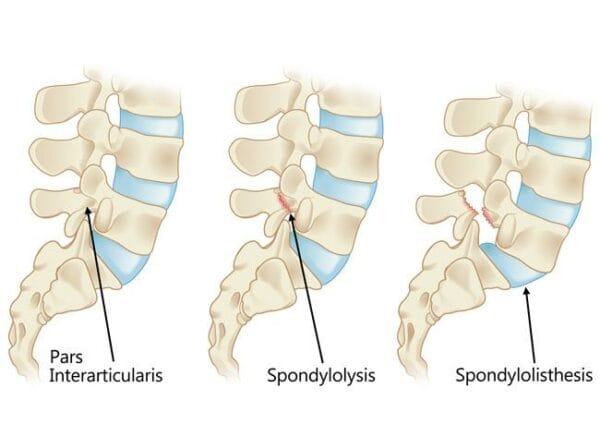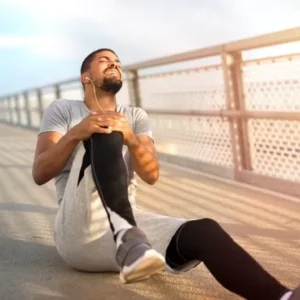Spondylolisthesis is a disorder of the spine that results in a forward or backward slippage of one vertebra on an adjacent one. Spondylolisthesis usually happens in the lower back region, also known as the lumbar area. Spondylolisthesis has an adverse impact on the daily lifestyle and therefore it is suggested to visit a good physiotherapist in such a condition. You can visit our Physiotherapy clinics in GTA to reduce the pain and impact of Spondylolisthesis.
Types of Spondylolistheses
Spondylolisthesis can be categorized into five major types –
1. Isthmic Spondylolisthesis – This is caused by a defect in pars interarticularis – a part of the vertebra. This condition usually leads to the vertebrae slipping forward.
2. Degenerative Spondylolisthesis – This condition is usually caused when the joints lose their capacity to keep the spine alignment at the normal position. This may result in the vertebrae slipping forward.
3. Congenital Spondylolisthesis – Congenital health issues are the ones that are present in a person since birth. Sometimes there is an abnormal formation of spinal bones during pregnancy at the time of development of the baby. Here the spinal discs slip due to misalignment and malformation.
4. Traumatic Spondylolisthesis – This is caused as a result of any injury or trauma leading to slipping of the spinal discs. It is important to note that here the term traumatic indicates an injury causing damage to the spinal discs.
5. Pathologic Spondylolisthesis – This disorder is a result of a disease affecting the healthiness of the spinal bones thereby weakening the same. Diseases like osteoporosis can cause Pathological Spondylolisthesis.
Causes of Spondylolisthesis
Spondylolisthesis affects children and adults differently. Let’s first understand Spondylolisthesis in children. It usually occurs between the fifth bone in the lumbar vertebra and the first bone in the sacrum, also known as the pelvis region. This is resulted either from acute trauma or a congenital disability in the spinal discs.
Spondylolisthesis in adults is caused by degenerative arthritis, which is abnormal wear on the cartilage and bone of the spine.
Spondylolisthesis is also caused by factors like accidents/fractures and bone diseases. Sports activities like gymnastics, weightlifting, and football add a lot of stress to the bones in the lower back. These sports require the athlete to continuously overstretch the spinal column. This can lead to a stress fracture of the spinal vertebra. A stress fracture can make the spinal bone weak and shift it out of place.
Symptoms of Spondylolisthesis
The symptoms of Spondylolisthesis may vary from case to case and person to person. A patient might not experience any symptoms of Spondylolisthesis in the initial stage. However, in the case of chronic conditions, the patient may find trouble in performing daily activities. We are listing below some of the common symptoms of Spondylolisthesis.
• Continuous pain in the lower back
• Stiffness in lower back and legs
• Sciatica – Muscle weakness or tightness in the lower limbs
• Tenderness in the lower back
• Pain in thighs
• Tightness in buttock muscles and hamstring
These are some of the most commonly experienced symptoms of Spondylolisthesis which are usually aggravated by activities like walking, standing, etc. Taking rest at that time provides temporary relief. It is suggested to go for specific Spondylolisthesis exercises for a proper pain relief program. This would involve a dedicated physiotherapy plan. Herein a physiotherapist will provide a care-based program that will be based on your case and medical history.
Spondylolisthesis Exercises
Studies have shown that Spondylolisthesis exercises provide relief and ease the pain to people suffering from Spondylolisthesis. These exercises can include lumbar extension and flexion and strengthening the lower back and abdominal muscles. Spondylolisthesis exercises also help in strengthening the back and core muscles which will not only increase flexibility in the back but also prevent spine slippage.
Depending on your injury and medical history, some Spondylolisthesis exercises are not recommended. You should also check out with your physiotherapist for Spondylolisthesis exercises to avoid.
Let’s now take you through some easy and beneficial Spondylolisthesis exercises.
• Plank – Start this exercise by getting into a standard push-up position. Your hands should remain on your shoulders. Try to stabilize your body using your toes thereby tightening your abdomen. Your body should be firm in this position with your head aligned to your back. Make sure that your knees are firm, but not locked. Your face should be facing downwards towards the floor. Hold this position for 30 seconds.
• Knee to chest – Start with your back, bend your knees, and keep your feet flat on the floor. Lift one of your knees towards the chest. While you do this, make sure that your lower back and opposite footrest firmly against the floor. Hold the position for 15 – 30 seconds. Alternate with the other leg and repeat the steps two to four times.
• Dead bug – Lay on your back and extend your hands above you towards the ceiling and move your feet, knees, and hips up to form a 90-degree angle. Make sure that your back is flattened. Inhale and rotate your pelvis as you squeeze your glutes. Exhale and lower your left leg and right arm together until your back starts to pain a bit. After this, go back to the starting position and alternate sides 10 – 12 times.
• Hamstring stretch – Start this Spondylolisthesis exercise by sitting on the ground and stretching your legs in from of you. Lean forward and reach out to your toes. You will feel a stretch throughout the back of your legs. Try to hold this position for at least 30 seconds. You should do a set of five to stretch your hamstrings and decrease the spondylolisthesis pain.
• Trunk rotation – For this Spondylolisthesis exercise, lie on your back and bend your knees keeping the feet firm on the ground. Keep your arms by your side, slowly rotate your knees to the right as far as it can go. Repeat the same on the left side. Practice this trunk rotation exercise 10 times for each side.
• Gluteal stretch – This is a wonderful Spondylolisthesis exercise to provide an extra stretch for the leg and lower muscle. Begin on your back and with bent knees, slowly pull one leg close to the chest for 10 seconds. Alternate sides and repeat five times.
These are some of the basic Spondylolisthesis exercises. It is important to note that these exercises are not a substitute for medical advice. Those seeking specific medical advice should visit our physiotherapy clinics in GTA. At Triangle Physiotherapy, we provide a host of services, treatments, and procedures based on your injury and/or health condition. You can write to us and our team will get back to you to answer your specific queries or doubts.





